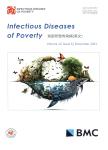Spatial-temporal pattern of cutaneous leishmaniasis in Brazil
Spatial-temporal pattern of cutaneous leishmaniasis in Brazil作者机构:Departsmento de EcologiaInstituto de BiocienciasUniversidade de Sao PauloSao PauloBrazil lnstituto de Fisica TeoricaUniversidade Estadual PaulistaSao PauloBrazil.
出 版 物:《Infectious Diseases of Poverty》 (贫困所致传染病(英文))
年 卷 期:2021年第10卷第3期
页 面:47-57页
核心收录:
学科分类:1004[医学-公共卫生与预防医学(可授医学、理学学位)] 1002[医学-临床医学] 1001[医学-基础医学(可授医学、理学学位)] 100206[医学-皮肤病与性病学] 10[医学]
基 金:supported by the Coordena Co de Aperfeigoamento de Pessoal de Nivel Superior-Brazil(Finance Code 001 toTPP) Conselho Nacional de Desenvolvimento Cientifico elecnologico-Brazil(Grant Number:311832/2017-2 to RAK) Fundacao de Amparo a Pesquisa do Estado de Sao Paulo-Brazil(contract number:2016/01343-7 to RAK)
主 题:Cutaneous leishmaniasis Spatiotemporal cluster Emerging hotspot Temporal trend Brazil
摘 要:Background:Cutaneous leishmaniasis(CL)is a vector-borne disease classified by the World Health Organization as one ofthe most neglected tropical *** has the highest incidence of CL in America and is one of the ten countries in the world with the highest number of *** the spatiotemporal dynamics of CL is essential to provide guidelines for public health policies in *** the present study we used a spatial and temporal statistical approach to evaluate the dynamics ofCL in ***:We used data of cutaneous leishmaniasis cases provided by the Ministry of Health of Brazil from 2001 to *** calculated incidence rates and used the Mann-Kendall trend test to evaluate the temporal trend of CL in each *** addition,we used Kuldorff scan method to identify spatiotemporal clusters and emerging hotspots test to evaluate hotspot areas and their temporal ***:We found a general decrease in the number of CL cases in Brazil(from 15.3 to 8.4 cases per 100000 habitants),although 3.2%of municipalities still have an increasing tendency of CL incidence and 72.5%showed no tendency at *** scan analysis identified a primary cluster in northern and central regions and 21 secondary clusters located mainly in south and southeast *** emerging hotspots analysis detected a high spatial and temporal variability of hotspots inside the main cluster area,diminishing hotspots in eastern Amazon and permanent,emerging,and new hotspots in the states of Amapa and parts of Para,Roraima,Acre and Mato *** central coast the state of Bahia is one of the most critical areas due to the detection of a cluster of the highest rank in a secondary cluster,and because it is the only area identified as an intensifying ***:Using a combination of statistical methods we were able to detect areas of higher incidence of CL and understand how it changed over *** suggest that these areas,especially those identified as perman



